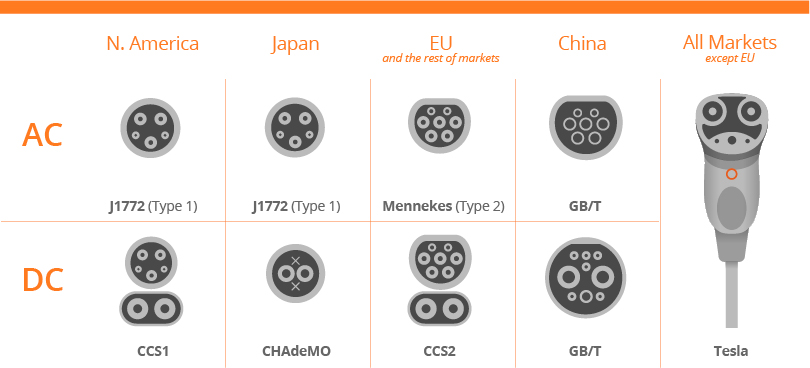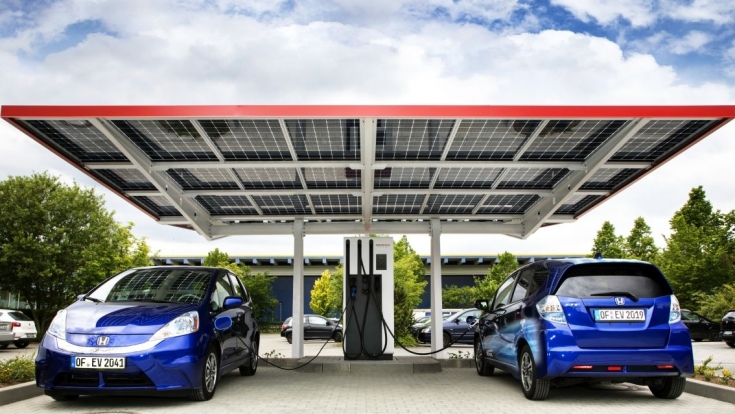There are many reasons to consider switching from a gasoline-powered car, to one that’s powered by electricity. Electric vehicles are quieter, cost less to operate and produce far fewer total emissions well to wheel. However, not all electric cars and plugs are created equal. In particular, the EV charging connector or plug type standard varies across geographies and models. While there is contention around universal plug technology, there is critical mass from global automakers supporting the Combined Charging System (CCS) in North America and Europe, while Japan and its automakers use CHAdeMO, and China, which has the world’s largest electric vehicle market uses GB/T.
Also, depending on the plug type within each region, there are different levels of power available. We will zero in on all these differences and other relevant information regarding charging electric vehicles below.
North American EV Plug Standards
In North America, every electric vehicle manufacturer (except Tesla) uses the SAE J1772 connector, also known as the J-plug, for Level 1 (120 volt) and Level 2 (240 volt) charging. Tesla provides a Tesla charger adapter cable with every car they sell that allows their cars to use charging stations that have a J1772 connector. This means that every electric vehicle sold in North America can use any charging station that comes with the standard J1772 connector.
That’s important to know because every non-Tesla level 1 or level 2 charging station sold in North America utilizes the J1772 connector. For example, all of our JuiceBox products use the standard J1772 connector. However, Tesla vehicles can charge on any JuiceBox charging station, by using the adapter cable that Tesla includes with the car. Tesla makes their own charging stations, that use a proprietary Tesla connector, and EVs from other brands cannot use them unless they purchase an adapter.
This might seem a little confusing, but one way to look at it is any electric vehicle you buy today can use a charging station that has a J1772 connector, and every level 1 or level 2 charging station available today uses the J1772 connector, except those made by Tesla.
DC Fast Charge EV Plug Standards in North America
It’s a little more complicated for DC fast charging, which is high-speed EV charging that is only available in public areas, most frequently along major freeways where long-distance travel is common. DC fast chargers aren’t available for at home charging, as the electricity requirements are usually not available in residential buildings. Also, it’s not recommended to use DC fast charging stations more than once or twice a week, because the high rate of recharging can adversely affect the lifespan of an electric car’s battery if done too often.
DC fast chargers use 480 volts and can recharge an electric vehicle faster than your standard charging unit, in as little as 20 minutes, thus allowing for convenient long-distance EV travel, without the concern of running out of juice. Unfortunately, instead of only two different connectors, as used in level 1 and level 2 charging (J1772 and Tesla), DC Fast Chargers use three different types of connectors.
CCS (Combined Charging System): The CCS connector uses the J1772 charging inlet, and adds two more pins below. It “combines” the J1772 connector with the high speed charging pins, which is how it got its name. CCS is the accepted standard in North America, and was developed and endorsed by the Society of Automotive Engineers (SAE). Just about every automaker today has agreed to use the CCS standard in North America, including: General Motors (all divisions), Ford, Chrysler, Dodge, Jeep, BMW, Mercedes, Volkswagen, Audi, Porsche, Honda, Kia, Fiat, Hyundai, Volvo, smart, MINI, Jaguar Land Rover, Bentley, Rolls Royce and others.
CHAdeMO: CHAdeMo was developed by the Japanese utility Tepco. It is the official standard in Japan, and virtually all DC fast chargers in Japan use a CHAdeMO connector. It’s different in North America, where the only manufacturers currently selling electric vehicles that use the CHAdeMO connector are Nissan and Mitsubishi. The Nissan LEAF and the Mitsubishi Outlander PHEV are the only electric vehicles that use the CHAdeMO EV charging connector type. In 2018, Kia abandoned CHAdeMO and now offers CCS. Unlike the CCS system, CHAdeMO connectors do not share part of the connector with the J1772 inlet, so they require an additional ChadeMO inlet on the car. This necessitates a larger charge port area, to accommodate two separate charging sockets.
Tesla: Tesla uses the same connector for level 1, level 2 and DC fast charge. It’s a proprietary Tesla connector that accepts all voltage, so there’s no need to have a different connector specifically for DC fast charge, as the other standards require. Only Tesla vehicles can use their DC fast chargers, called Superchargers. Tesla installed and maintains these stations, and they are for the exclusive use of Tesla customers.
Post time: Jun-15-2020


